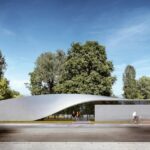
Whether it is a small balcony, access to green space or a private garden, the outdoor space has become a privilege for many, especially upon the dawn of the Covid-19 pandemic and the multiple lock down periods that followed. Green space in the city is constantly under threat, particularly since governments seek to increase housing densities in order to feed a growing demand for suburban development. As a result, the garden and access to green/outdoor spaces has decreased in recent times, as priorities lie in housing as many as possible, often with disregard to beneficial features such as access to outdoor areas in residential developments.
In terms of living conditions the lack of access to these spaces presents evident inequalities, uncovered during periods of lock down and restrictions during the pandemic. People were confined to their homes and local outdoor spaces, where they could exercise. Those who had access to these public spaces and had their own gardens/external space were very lucky in the sense that they were able to enjoy an element of the outside. While those less fortunate in flats and areas of depravity faced claustrophobic and demoralizing conditions, contained within the shell of their homes.

Access to quality green space has become an essential for urban dwellers. A report by Vivid Economics and Barton Willmore showed that nearly two-thirds of the population in the UK have appreciated local green spaces more due to Covid-19 and that they want them to be a higher priority for the government.
Income is predominantly linked to accessibility to green/outdoors spaces, with 1 in 8 British households having no garden. Those in semi-skilled and unskilled manual occupations, the unemployed and casual workers being three times as likely as those in administrative, managerial and professional occupations to be without a garden. (A comparative 20% to 7%). According to survey data from Natural England, ethnic minorities are nearly four times as likely to have no access to outdoor space at home (including the presence of a private/shared garden, a patio or balcony). An astonishing 37% compared to 10%. This highlights the disproportionate access to private external spaces within the community.

According to research by Lorien Nesbitt, assistant Professor at the University of British Columbia, generally speaking green space is harder to access in lower-income neighborhoods. In more affluent areas it is far easier to find a form of garden, balcony, rooftop and even micro parks and trees, since these require both investment and maintenance. Public green spaces are often funded by city budgets and councils, meaning investment and quality varies due to how different areas prioritize these budgets.
The garden/private outdoor space as a privilege becomes apparent when observing the negative effects of being trapped inside for prolonged periods of time. It presents numerous side effects including mental and physical health issues, such as reduced brain function, depression and a weakened immune system.

As emphasized by Anna Wirz-Justice, daylight award winner 2022, daylight is essential for health and this light exposure synchronizes the circadian timing system. Without this daily synchronization consequences such as irritability, fluctuations in mood and reduced concentration can occur. Long term, there is an increased risk of cardiovascular disease, cancer, mental illness and obesity. Reduced access to these spaces increases these risks, as exposure to daylight is limited.
Those residencies that incorporate outdoor/green space present positive effects on physiology, including improved longevity and concentration. The essence of ‘biophilia’, coming from our instinctual need as humans to be close to the natural world is crucial, and if we sever this tie through the built environment it can trigger stress, breaking the connection between the individual and the natural world.

To conquer this disparity, access to these spaces should be prioritized as both a method of greening our cities and improving overall mental and physical well being. Targeting deprived communities and those from lower socio-economic backgrounds to reinstate the garden/private outdoor space as a vital amenity for all, rather than a privilege for those more fortunate. It is key to note that greening solutions are not necessarily straightforward, as the benefits green spaces provide are influenced by local context, social disadvantage, culture and resident demographics. To maximize impact, green space can be most beneficial with input from the community, in areas of social disadvantage.
The idea of urban greening in our cities has very much become a tick box exercise, ignoring the extensive benefits outdoor space provides for residents. However, as our cities become more densely populated innovative new ways of incorporating green elements have arisen, including the popularization of vertical gardens, greening our facades and offering numerous physical and mental health benefits. Introducing elements of Biophilic design may also blur the lines between disparity. Incorporating houseplants and maximizing natural light offers subtle ways to offer access to benefits assumed through the natural world. Differing from the traditional private garden, these can offer a solution to reducing the garden privilege, among other innovative new schemes.
Source: ArchDaily


 Ελληνικά
Ελληνικά



